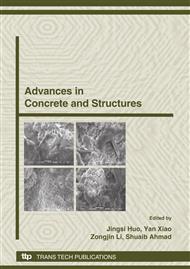p.181
p.187
p.195
p.203
p.211
p.215
p.221
p.227
p.233
Sulfate-Ion Diffusion Regularity and Reaction Mechanism of Sodium Sulfate Attack on Carbonized Concrete
Abstract:
The experiment has been carried out to study the sodium sulfate attack on carbonized concrete. The concrete specimens with strength grade of C50 were first carbonized for 28d in the carbonation box after standard curing, and then immersed into the sodium sulfate solutions of three different concentrations. When the immersed time were up to 30d, 90d, 180d, 270d and 360d, the sulfate-ion concentrations of every layer from the surface to the inside of concrete specimen were measured by the chemical titration method. Based on the test results, the sulfate-ion diffusion regularity and the reaction mechanism of carbonized concrete are analyzed. It can be concluded that the sulfate-ion diffusion regularity and the reaction mechanism of carbonized concrete is completely different from that of un-carbonized concrete, the diffusion of sulfate-ion occupies advantage in the pore water of carbonized concrete, which increases the depth of concrete specimen attacked by sulfate solution.
Info:
Periodical:
Pages:
211-214
Citation:
Online since:
October 2008
Authors:
Price:
Сopyright:
© 2009 Trans Tech Publications Ltd. All Rights Reserved
Share:
Citation:


